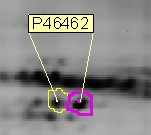Protein phosphorylation
Protein phosphorylation is a biochemical process that involves the addition of a phosphate group to a protein molecule. This process is a crucial post-translational modification that regulates the function, activity, and interaction of proteins within the cell.
Mechanism[edit | edit source]
Protein phosphorylation is typically catalyzed by enzymes known as protein kinases. These enzymes transfer a phosphate group from a high-energy molecule, such as adenosine triphosphate (ATP), to specific amino acid residues in the target protein. The most common residues that undergo phosphorylation are serine, threonine, and tyrosine.
Function[edit | edit source]
Phosphorylation plays a key role in various cellular processes, including:
- Signal transduction: Phosphorylation acts as a molecular switch that can turn on or off the activity of proteins involved in signaling pathways.
- Cell cycle regulation: Phosphorylation controls the progression of cells through the cell cycle by regulating the activity of cyclin-dependent kinases (CDKs).
- Metabolism: Enzymes involved in metabolic pathways are often regulated by phosphorylation, which can alter their activity and thus the metabolic flux.
- Apoptosis: Phosphorylation can either promote or inhibit programmed cell death, depending on the context and the specific proteins involved.
Dephosphorylation[edit | edit source]
The removal of phosphate groups from proteins, known as dephosphorylation, is carried out by enzymes called protein phosphatases. This process is equally important as phosphorylation and ensures that the phosphorylation state of proteins is tightly regulated.
Clinical Significance[edit | edit source]
Abnormal protein phosphorylation is associated with various diseases, including cancer, diabetes, and neurodegenerative disorders. For instance, overactive kinases can lead to uncontrolled cell proliferation in cancer, while impaired phosphorylation of insulin receptors is a hallmark of diabetes.
Related Pages[edit | edit source]
See Also[edit | edit source]
References[edit | edit source]
| Biochemistry | ||||||||||
|---|---|---|---|---|---|---|---|---|---|---|
This biochemistry related article is a stub.
|
Search WikiMD
Ad.Tired of being Overweight? Try W8MD's physician weight loss program.
Semaglutide (Ozempic / Wegovy and Tirzepatide (Mounjaro / Zepbound) available.
Advertise on WikiMD
|
WikiMD's Wellness Encyclopedia |
| Let Food Be Thy Medicine Medicine Thy Food - Hippocrates |
Translate this page: - East Asian
中文,
日本,
한국어,
South Asian
हिन्दी,
தமிழ்,
తెలుగు,
Urdu,
ಕನ್ನಡ,
Southeast Asian
Indonesian,
Vietnamese,
Thai,
မြန်မာဘာသာ,
বাংলা
European
español,
Deutsch,
français,
Greek,
português do Brasil,
polski,
română,
русский,
Nederlands,
norsk,
svenska,
suomi,
Italian
Middle Eastern & African
عربى,
Turkish,
Persian,
Hebrew,
Afrikaans,
isiZulu,
Kiswahili,
Other
Bulgarian,
Hungarian,
Czech,
Swedish,
മലയാളം,
मराठी,
ਪੰਜਾਬੀ,
ગુજરાતી,
Portuguese,
Ukrainian
Medical Disclaimer: WikiMD is not a substitute for professional medical advice. The information on WikiMD is provided as an information resource only, may be incorrect, outdated or misleading, and is not to be used or relied on for any diagnostic or treatment purposes. Please consult your health care provider before making any healthcare decisions or for guidance about a specific medical condition. WikiMD expressly disclaims responsibility, and shall have no liability, for any damages, loss, injury, or liability whatsoever suffered as a result of your reliance on the information contained in this site. By visiting this site you agree to the foregoing terms and conditions, which may from time to time be changed or supplemented by WikiMD. If you do not agree to the foregoing terms and conditions, you should not enter or use this site. See full disclaimer.
Credits:Most images are courtesy of Wikimedia commons, and templates, categories Wikipedia, licensed under CC BY SA or similar.
Contributors: Prab R. Tumpati, MD




